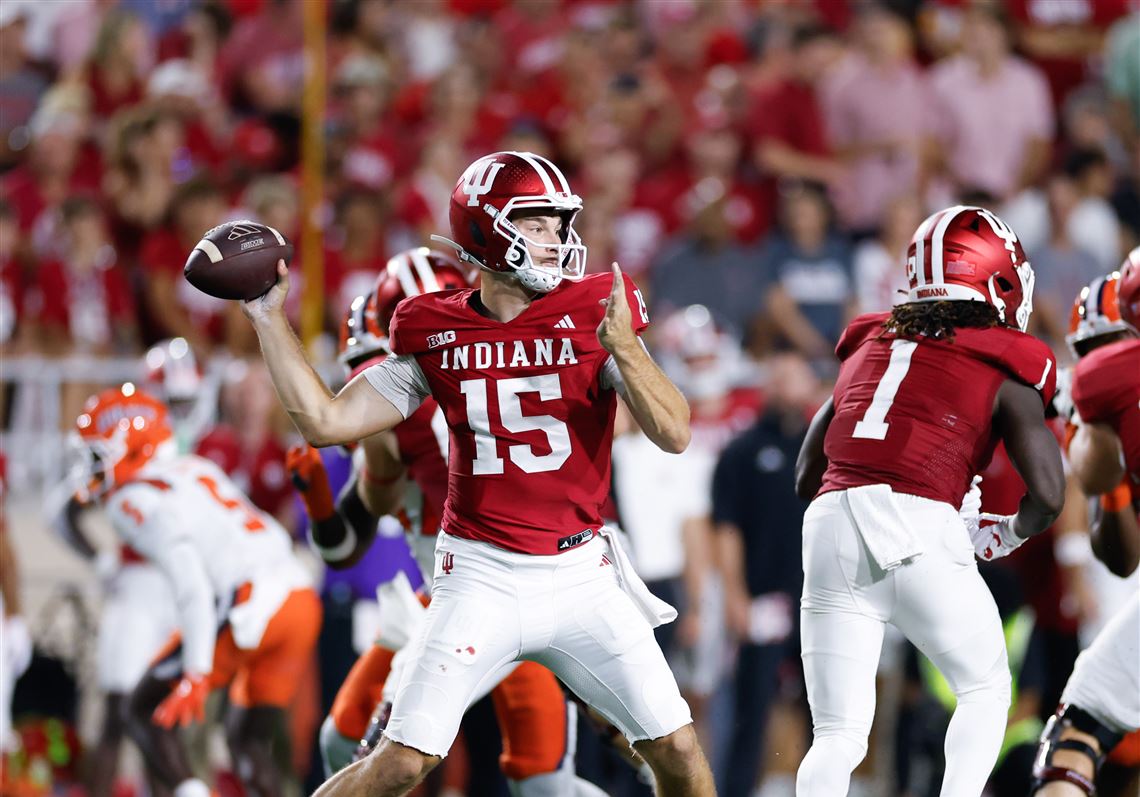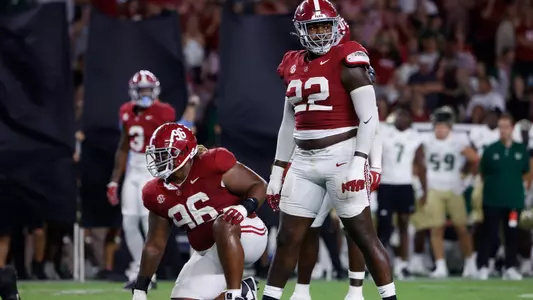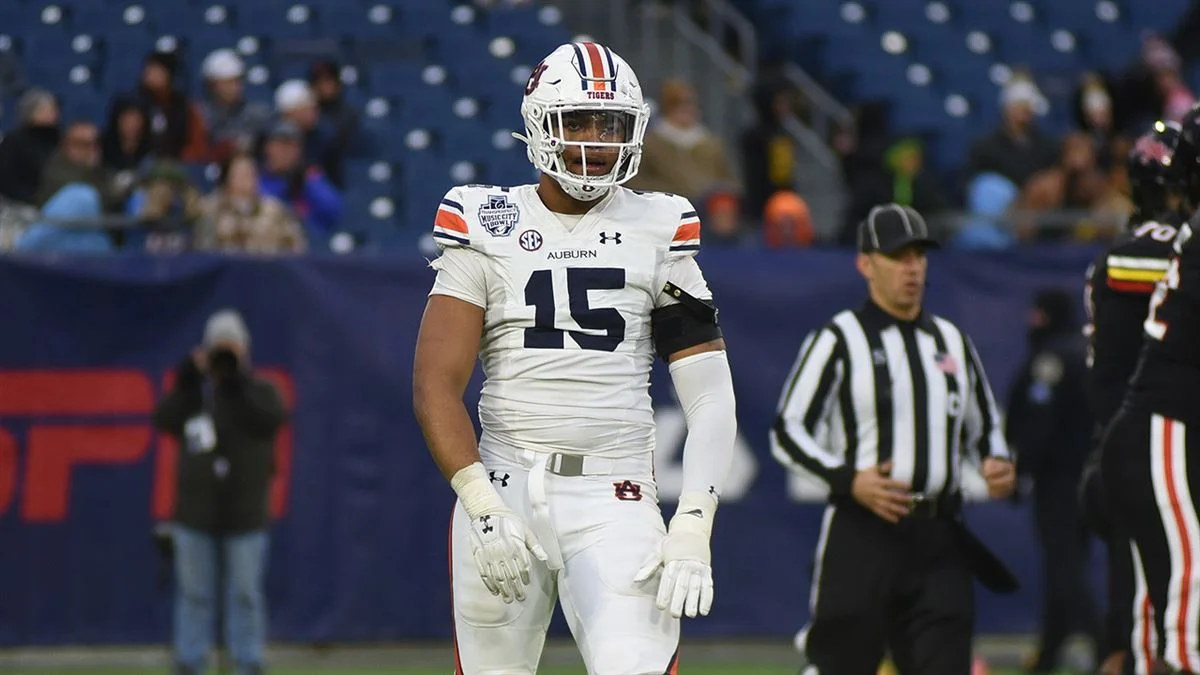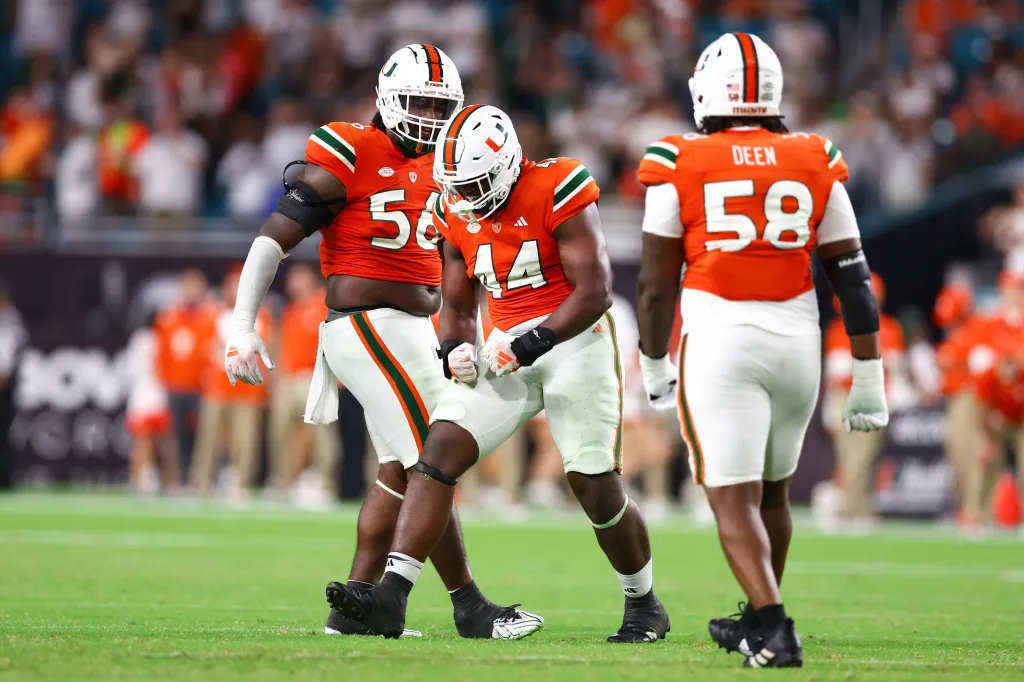By Charlie Campbell.
Send Charlie an e-mail here: [email protected]
Follow Charlie on Twitter @draftcampbell for updates.
This page was last updated March 18, 2016. Follow me @walterfootball for updates.
Position Review: Defensive Tackles
Defensive Tackle Class
Early-round talent: A+
Mid-round: A
Late-round: A-
Overall grade: A+
Merging the 2016 and 2015 prospects
Leonard Williams
Danny Shelton
Sheldon Rankins
Arik Armstead
A’Shawn Robinson
Jarran Reed
Robert Nkemdiche
Malcom Brown
Vernon Butler
Jonathan Bullard
Kenny Clark
Adolphus Washington
Mario Edwards Jr.
Eddie Goldman
Jordan Phillips
Carl Davis
This marks the fourth straight season where there is a strong class of defensive tackles, yet the 2016 group could be the best of the bunch because it is loaded with talent. There are interior defensive lineman who will go in Rounds 3-5 who would be selected a round or two higher in a normal year.
If you were to merge the two classes, there is a lot of equality. Leonard Williams was the best prospect over the past two years. Rankins is on a par with Shelton and Armstead as a teens-level prospect. After that group, there is a trio of talented SEC lineman in Robinson, Reed and Nkemdiche. They would be ahead of 2015’s Malcom Brown as a prospect.
Starting with Butler, the rest of the group is second-day, or likely to be second-day, picks. The only difference is the 2016 trio of Bullard, Clark and Washington consists of better prospects than the Day 2 players from 2015.
There also are some other good defensive line prospects who could go in the top 60 this year who aren’t mentioned above. That group includes Baylor’s Andrew Billings, Notre Dame’s Sheldon Day, Penn State’s Austin Johnson, Nebraska’s Maliek Collins, Illinois’ Jihad Ward and Mississippi State’s Chris Jones. It wouldn’t surprise me if some the players in this second group turn out to be studs in the NFL. If I had the time, I could do another position review on another set of tackles because this group led by Day, Ward, and Jones all could get first- or second-round consideration in a normal year.
Beyond them, there are other good prospects that will go in the mid-rounds like South Carolina State’s Javon Hargrave, Michigan’s Willie Henry, Texas’ Hassan Ridgeway and Temple’s Matt Ioannidis. The 2016 NFL Draft is absolutely loaded with interior defensive linemen.
Safest Pick: Jarran Reed, Alabama

Reed may not turn into a dynamic disruptor at the point of attack, but he is very safe pick to be a solid pro and tough run defender. The 6-foot-3, 311-pounder is very strong at the point off attack with the ability to shed blocks. In college, he wasn’t much of a pass-rusher, but he has the quickness to develop more skills in this category. Even if Reed doesn’t turn into a contributing pass-rusher, he looks very safe to have a long career as a nose tackle in a 4-3 or 3-4 defense.
Looking at the past years, I was way off on Nix. Lotulelei has been good for Carolina, and Williams had a respectable start for the Jets.
2015 Pick: Leonard Williams
2014 Pick: Louis Nix
2013 Pick: Star Lotulelei
Biggest Bust Potential: Robert Nkemdiche, Ole Miss

This wasn’t a difficult choice. Nkemdiche has been ridiculously overhyped. On the field, he lacks awareness, consistency and rarely ever finishes a play. Hence, he has a total of seven sacks from three years as a starter. Off the field, Nkemdiche is a mess and his older bother is said to be a bad influence who will follow him to be part of his entourage in his NFL city.
Some sources have said that Nkemdiche isn’t serious about football and wants to be a movie star rather than being possessed to be the best player he can possibly be. In the combine interviews, other sources said Nkemdiche came off as a stoner who was too good for everyone.
With him having significant flaws on the field and problems off the field, I think Nkemdiche is the most likely to be a bust and not deliver on the tremendous skill set he was blessed with.
Reviewing the past, I could be wrong about Edwards as he flashed some as a rookie. I was right about Anthony Johnson and Jesse Williams, although both fell in the draft and weren’t the early round prospects who some made them out to be.
2015 Pick: Mario Edwards Jr.
2014 Pick: Anthony Johnson
2013 Pick: Jesse Williams
Defensive Tackles Rankings by Attributes
Pass Rush:
NFL prototype: J.J. Watt, Texans
- Sheldon Rankins
- Jonathan Bullard
- Adolphus Washington
- A’Shawn Robinson
- Vernon Butler
- Robert Nkemdiche
- Kenny Clark
- Jarran Reed
Recap: The NFL is always searching for interior linemen who can get after the quarterback. They are a hard commodity to find, and one can make a massive impact on a team’s ability to rush the passer. Tackles who can rush the quarterback set up a lot of sacks for edge rushers via disruption and double-teams. The fastest way to get to a quarterback is from up the middle, and even just forcing quarterbacks to get off their drop-spot hurts the passing game.
Rankins is the most natural pass-rusher of this group. He has natural pad level with the speed to fire the gap and chase down the quarterback. At the Senior Bowl, Rankins was tremendous in the one-on-ones and showed a lot of skill at getting to the quarterback. He had six sacks in 2015 and nine the previous year, so he has the production from college to back it up.
Bullard is a very good pass-rusher for an interior lineman. He is a speed rusher who can dart by guards and close on the quarterback in a hurry. Bullard also has functional strength to fight off guards. Last year, he had the biggest sack total of any player in this group of prospects. As a three-technique, Bullard could be a dangerous pass-rusher and produce quality sack totals in the NFL.
Washington has similar ability to Bullard, but might not be as athletic. However, Washington consistently fires by guards to collapse the pocket and create disruption. He is a talented interior rusher with eight sacks over the past two seasons.
Robinson and Butler both have a special skill set but lack consistency. At the Senior Bowl, Butler played well and showed the ability to get into the backfield. Robinson also had some excellent games rushing the passer in college, but he was far too inconsistent. Both players have the upside to develop into good pass-rushers in the NFL if they land with good coaching and are motivated.
The same thing applies to Nkemdiche. He has a great speed and natural strength to get after the quarterback. However, he lacks awareness to redirect and finish plays.
Clark isn’t just a heavy nose tackle as he had six sacks last year. Some of those sacks came against weak competition and won’t be duplicated in the NFL. However, he still is powerful to toss linemen to the side and get after the quarterback. Clark could produce quality sack numbers for a nose tackle and be an asset as a tackle who can put steady push down the middle to prevent quarterbacks from being able to step up. He showed nice speed and athleticism at the combine for a nose tackle.
Reed has the speed and athleticism to function in the pass rush, but he just hasn’t shown it yet. He has two sacks over the past two years. An NFL team can’t bank on Reed becoming a pass-rusher.
Run Defense:
NFL prototype: J.J. Watt, Texans
- Jarran Reed
- Kenny Clark
- A’Shawn Robinson
- Jonathan Bullard
- Vernon Butler
- Robert Nkemdiche
- Sheldon Rankins
- Adolphus Washington
Recap: There really isn’t a player in this group who I would say is a bad in terms of stopping the rush. Reed is an excellent run defender. He is extremely strong at the point of attack and stuffs runs that come his direction. He can eat up double-teams to fill his gap and hold his ground at the line of scrimmage. Reed also can burst into the backfield or flow down the line to make tackles. He is very good in short-yardage situations as well.
Clark is a heavy run stuffer at the point of attack, but he also can get outside of his gap to stop ball-carriers. In 2015, he had 75 tackles with 11 tackles for a loss, and that is a very impressive total for a nose tackle. Clark’s run defense is NFL-ready.
Bullard and Robinson are about equal. Right now, Bullard is better, but projecting for the NFL, Robinson has a skill set that is better suited to stopping ground games. However, Bullard was an awesome run defender last year who held his ground, made tackles at the line, and also exploded into the backfield to stop runs. The only reason he’s ranked fourth is because he weighs in the 280s, and that is undersized for a NFL interior defensive lineman.
Butler is a solid run defender. He has the size and strength to hold up at the point of attack. Nkemdiche flashes brilliance, but is far too inconsistent. In some games, he’s a ghost. There are also plays where he bull rushes a guard straight back but he doesn’t disengage to make or set up a tackle. Hence, he has poor awareness.
Rankins and Washington are quality run defenders, but could stand to improve some in this area for the NFL.
Speed:
NFL prototype: Gerald McCoy, Buccaneers
- Robert Nkemdiche
- Jonathan Bullard
- Adolphus Washington
- Sheldon Rankins
- A’Shawn Robinson
- Kenny Clark
- Jarran Reed
- Vernon Butler
Recap: All of these tackles have speed, which is pretty impressive. There isn’t a whole lot that separates the top four especially. Nkemdiche is the fastest with his get-off and ability to fly around the field. Bullard can beat tackles with speed rushes, and that sets him apart from the others. Washington and Rankins also are fast defenders at the point of attack. They can knife into the backfield with a burst that catches blockers by surprise.
Robinson has a lot of speed for a big, thick tackle. However, it seems to be turned on and off. If he were more consistent, he would be ranked higher.
Clark and Reed have surprising quickness for tough nose tackles. Both can flow down the line and close on ball-carriers.
Butler has serious quickness to his game, and nobody would say he’s a plodder. He can fire by a guard and get to the quarterback with his speed. Even though Butler is ranked last, speed isn’t a weakness of his game and he has a well-rounded skill set.
Strength:
NFL prototype: Ndamukong Suh, Dolphins
- Jarran Reed
- Kenny Clark
- A’Shawn Robinson
- Robert Nkemdiche
- Vernon Butler
- Sheldon Rankins
- Adolphus Washington
- Jonathan Bullard
Recap: Reed and Clark are definitely the strongest of the defenders. They can hold their ground against double-teams and have the strength to toss blockers to the side.
Nkemdiche (6-3, 294) weighs less than some of these linemen, but Nkemdiche has natural power to him. He can bull rush offensive linemen with violence. He just doesn’t do it consistently.
Robinson and Butler are very strong as well. Offensive linemen can’t push them around, and they can bully blockers into the backfield. Both have shown the ability to beat some double-teams as well. Butler (6-3) gets into trouble when he stands up too high. When he does that, he loses leverage and his strength goes away, thus he’s behind some of the others.
Rankins is strong for his size. He plays with good leverage with the upper body strength to shed blocks at the point of attack. For the NFL, Rankins won’t overwhelm offensive linemen with power.
Washington (6-3, 301) doesn’t lack for strength, but doesn’t show it enough for it to be considered an asset. He is a speed defender. Bullard was very strong in SEC play last year – surprisingly so – but at 285 pounds, he could stand to add more power for the NFL.
Three-Technique:
NFL prototype: Geno Atkins, Bengals
- Sheldon Rankins
- Jonathan Bullard
- Adolphus Washington
- Robert Nkemdiche
- Vernon Butler
- A’Shawn Robinson
- Kenny Clark
- Jarran Reed
Recap: Good three-techniques are generally hard to find, but this draft class has a bunch of them. The first four above have all shown the ability to be skilled three-techniques. Rankins’ speed, pass-rush ability and get-off give him the top spot. He is a natural three-technique who would be a great fit in a Tampa 2.
Bullard and Washington are just a little below Rankins. In 2015, Bullard was very good as a three-technique given the way he fired into the gap off the guard’s outside shoulder. The speedy tackle was disruptive, which is what a three-technique needs to do more than anything else. Washington was the same. He is very fast at the point of attack and can dart by offensive linemen. Washington is a natural speed rusher.
Nkemdiche also has the speed to be a three-technique in the NFL. Playing that role where he fights to get upfield and cause disruption could be his best fit in the NFL. However, his lack of awareness to finish plays puts him behind the others.
Butler and Robinson are both fits as three-techniques with their speed and athleticism. Both prospects have a lot of upside. Robinson is a little heavier than most three-techniques, but in some ways, that adds to his intrigue as a power three-technique and run defender for a 4-3 team. Robinson has the speed and athleticism to play the position, but he wasn’t consistent enough at causing havoc in the backfield to be viewed as a true three-technique.
Clark and Reed have some quickness, but they are more nose tackles to play next to a true three-technique. If either one is drafted into a 4-3 scheme, he will be playing the nose.
3-4 Defensive End:
NFL prototype: J.J. Watt, Texans
- Robert Nkemdiche
- A’Shawn Robinson
- Jarran Reed
- Jonathan Bullard
- Vernon Butler
- Sheldon Rankins
- Kenny Clark
- Adolphus Washington
Recap: This group has a few 3-4 ends. Nkemdiche would be perfect to play a five-technique role. He has the length and strength to set the edge with the speed to add to the pass rush going against tackles or guards. Nkemdiche could be a nice fit as a 3-4 defensive end.
Robinson and Reed both would fit as 3-4 ends. They have enough length and good strength to set the edge. Both also would fit as 3-4 nose tackles, so they could play any position on the defensive line in that scheme.
Bullard lacks the length that most 3-4 teams want, but sources at 3-4 teams say they think they could get away with Bullard as a five-technique. He would bring a speed element to the position, and some 3-4 teams like to have some quickness and athleticism in their ends.
Butler is more of a nose tackle, but he could play some defensive end in a 3-4.
Washington, Rankins and Clark are all poor fits as 3-4 ends. Clark and Rankins don’t have the length that 3-4 teams look for in going against offensive tackles. Washington is more a speedy three-technique and isn’t a good fit in a 3-4.
3-4 Nose Tackle:
NFL prototype: Dontari Poe, Chiefs
- Kenny Clark
- Jarran Reed
- A’Shawn Robinson
- Vernon Butler
- Sheldon Rankins
- Robert Nkemdiche
- Adolphus Washington
- Jonathan Bullard
Recap: A good nose tackle in a 3-4 defense is a tough commodity to find. Someone like Vince Wilfork or Casey Hampton in their prime sets the tone for the pass rush and the run defense by blasting the center into the backfield. An effective zero-technique stuffs the run and occupies interior blockers to open up lanes for blitzes up the middle.
Clark and Reed played nose tackle for years and are very skilled at it. Clark is a natural zero-technique with his power, burst and body type. Reed has the strength and power to man the position. He could be a real asset for a 3-4 team moving around from tackle to end. Either could be a perfect fit manning the zero-technique in a 3-4 defense.
Robinson also could play nose tackle in a 3-4. He can line up over centers and overwhelm them. He is just about on a par with Reed, but Reed is more consistent as a run defender. In a few years though, Robinson could be a Pro Bowl nose tackle with his combination of power, speed and force. He has more upside than some others.
Butler would be a good fit in a 3-4 and could be a powerful force as a zero-technique. Rankins has enough skills to get consideration as a nose tackle, but he would be undersized. He isn’t a great fit in a 3-4 defense and is better off in a 4-3.
Nkemdiche, Washington and Bullard would all line up as an end in a 3-4 if they placed in that defense. None of them have the build to be a nose tackle in a 3-4.
2026 NFL Mock Draft - Jan. 7
NFL Picks - Jan. 7
NFL Power Rankings - Jan. 5
Fantasy Football Rankings - Sept. 1




